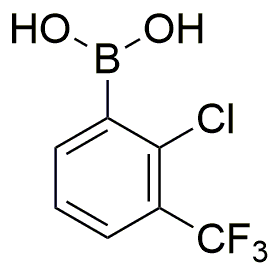2-Chloro-3-(trifluoromethyl)phenylboronic acid is widely utilized in research focused on:
- Pharmaceutical Development: This compound serves as a key intermediate in the synthesis of various pharmaceuticals, particularly in the development of drugs targeting cancer and other diseases.
- Organic Synthesis: It is employed in cross-coupling reactions, such as Suzuki-Miyaura reactions, allowing chemists to create complex organic molecules efficiently.
- Material Science: The compound is used in the formulation of advanced materials, including polymers and coatings, enhancing their properties like durability and resistance to environmental factors.
- Agricultural Chemistry: It plays a role in the development of agrochemicals, contributing to the creation of effective herbicides and pesticides that improve crop yields.
- Analytical Chemistry: This boronic acid derivative is utilized in sensor technology for detecting specific biomolecules, providing a reliable method for monitoring environmental and biological samples.
General Information
Properties
Safety and Regulations
Applications
2-Chloro-3-(trifluoromethyl)phenylboronic acid is widely utilized in research focused on:
- Pharmaceutical Development: This compound serves as a key intermediate in the synthesis of various pharmaceuticals, particularly in the development of drugs targeting cancer and other diseases.
- Organic Synthesis: It is employed in cross-coupling reactions, such as Suzuki-Miyaura reactions, allowing chemists to create complex organic molecules efficiently.
- Material Science: The compound is used in the formulation of advanced materials, including polymers and coatings, enhancing their properties like durability and resistance to environmental factors.
- Agricultural Chemistry: It plays a role in the development of agrochemicals, contributing to the creation of effective herbicides and pesticides that improve crop yields.
- Analytical Chemistry: This boronic acid derivative is utilized in sensor technology for detecting specific biomolecules, providing a reliable method for monitoring environmental and biological samples.
Documents
Safety Data Sheets (SDS)
The SDS provides comprehensive safety information on handling, storage, and disposal of the product.
Product Specification (PS)
The PS provides a comprehensive breakdown of the product’s properties, including chemical composition, physical state, purity, and storage requirements. It also details acceptable quality ranges and the product's intended applications.
Certificates of Analysis (COA)
Search for Certificates of Analysis (COA) by entering the products Lot Number. Lot and Batch Numbers can be found on a product’s label following the words ‘Lot’ or ‘Batch’.
*Catalog Number
*Lot Number
Certificates Of Origin (COO)
This COO confirms the country where the product was manufactured, and also details the materials and components used in it and whether it is derived from natural, synthetic, or other specific sources. This certificate may be required for customs, trade, and regulatory compliance.
*Catalog Number
*Lot Number
Safety Data Sheets (SDS)
The SDS provides comprehensive safety information on handling, storage, and disposal of the product.
DownloadProduct Specification (PS)
The PS provides a comprehensive breakdown of the product’s properties, including chemical composition, physical state, purity, and storage requirements. It also details acceptable quality ranges and the product's intended applications.
DownloadCertificates of Analysis (COA)
Search for Certificates of Analysis (COA) by entering the products Lot Number. Lot and Batch Numbers can be found on a product’s label following the words ‘Lot’ or ‘Batch’.
*Catalog Number
*Lot Number
Certificates Of Origin (COO)
This COO confirms the country where the product was manufactured, and also details the materials and components used in it and whether it is derived from natural, synthetic, or other specific sources. This certificate may be required for customs, trade, and regulatory compliance.


